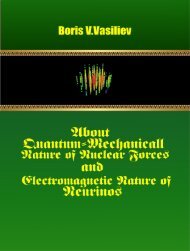978-1-940366-36-4_WholeBook
Boris V. Vasiliev Supercondustivity Superfluidity
Boris V. Vasiliev
Supercondustivity Superfluidity
Create successful ePaper yourself
Turn your PDF publications into a flip-book with our unique Google optimized e-Paper software.
Chapter 7 The Condensate of Zero-Point Oscillations and Type-I Superconductors<br />
Two electron pairs at an in-phase oscillations have a high energy of interaction and<br />
therefore cannot form the condensate. The condensate can be formed only by the particles<br />
that make up the difference between the populations of levels N 0 −N 1 . In a dimensionless<br />
form, this difference defines the order parameter:<br />
Ψ =<br />
N 0 N 1<br />
− . (7.5)<br />
N 0 + N 1 N 0 + N 1<br />
In the theory of superconductivity, by definition, the order parameter is determined by<br />
the value of the energy gap<br />
Ψ = ∆ T /∆ 0 . (7.6)<br />
When taking a counting of energy from the level ε 0 , we obtain<br />
∆ T<br />
∆ 0<br />
= N 0 − N 1<br />
N 0 + N 1<br />
≃ e2∆ T /kT − 1<br />
e 2∆ T /kT<br />
+ 1 = th(2∆ T /kT ). (7.7)<br />
Passing to dimensionless variables δ ≡ ∆ T<br />
∆ 0<br />
, t ≡ kT<br />
kT c<br />
and β ≡ 2∆0<br />
kT c<br />
we have<br />
δ = eβδ/t − 1<br />
= th(βδ/t). (7.8)<br />
e βδ/t + 1<br />
This equation describes the temperature dependence of the energy gap in the spectrum<br />
of zero-point oscillations. It is similar to other equations describing other physical<br />
phenomena, that are also characterized by the existence of the temperature dependence<br />
of order parameters [43], [44]. For example, this dependence is similar to temperature<br />
dependencies of the concentration of the superfluid component in liquid helium or the<br />
spontaneous magnetization of ferromagnetic materials. This equation is the same for all<br />
order-disorder transitions (the phase transitions of 2nd-type in the Landau classification).<br />
The solution of this equation, obtained by the iteration method, is shown in Figure 7.2.<br />
Science Publishing Group 79













